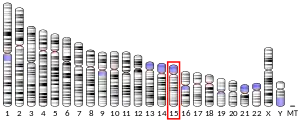| STRC | |||||||||||||||||||||||||||||||||||||||||||||||||||
|---|---|---|---|---|---|---|---|---|---|---|---|---|---|---|---|---|---|---|---|---|---|---|---|---|---|---|---|---|---|---|---|---|---|---|---|---|---|---|---|---|---|---|---|---|---|---|---|---|---|---|---|
| Identifiers | |||||||||||||||||||||||||||||||||||||||||||||||||||
| Aliases | STRC, DFNB16, stereocilin | ||||||||||||||||||||||||||||||||||||||||||||||||||
| External IDs | OMIM: 606440 MGI: 2153816 HomoloGene: 15401 GeneCards: STRC | ||||||||||||||||||||||||||||||||||||||||||||||||||
| |||||||||||||||||||||||||||||||||||||||||||||||||||
| |||||||||||||||||||||||||||||||||||||||||||||||||||
| |||||||||||||||||||||||||||||||||||||||||||||||||||
| |||||||||||||||||||||||||||||||||||||||||||||||||||
| Wikidata | |||||||||||||||||||||||||||||||||||||||||||||||||||
| |||||||||||||||||||||||||||||||||||||||||||||||||||
Stereocilin is a protein that in humans is encoded by the STRC gene.[5][6][7]
The STRC gene provides instructions for creating a protein called stereocilin, named for its location outside the stereocilia cells in the inner ear. This protein is associated with the hair bundle of the sensory hair cells in the inner ear. The hair bundle is composed of stiff microvilli called stereocilia and is involved with mechanoreception of sound waves. Stereocilia cells generate an electrical response to the vibrations of sound waves, crucial for normal hearing.
This gene is part of a tandem duplication on chromosome 15; the second copy is a pseudogene. Impairment of the STRC gene leads to the production of a non-functional stereocilin or prevents its production altogether. Consequently, this results in instability in the structure of stereocilia, hindering their optimal response to the passage of sound waves. In the end, the hair cells fail to convert sound waves into electrical potentials, causing hearing impairment. Hence, mutations in this gene cause autosomal recessive non-syndromic deafness.[7][8]
Mutations in STRC is the most common cause of moderate bilateral hearing loss, accounting for approximately 30% of cases.[9] The prevalence of hearing loss due to alterations in the STRC gene is estimated at 1 in 1600.[10]
99% of the genetic alterations in the STRC gene associated with non-syndromic hearing loss involve large copy number variations. Often, the alteration is a large deletion on chromosome 15, including several genes, among them STRC. In some cases, this deletion includes the CATSPER2 gene, which can lead to fertility issues in males.
References
- 1 2 3 GRCh38: Ensembl release 89: ENSG00000242866 - Ensembl, May 2017
- 1 2 3 GRCm38: Ensembl release 89: ENSMUSG00000033498 - Ensembl, May 2017
- ↑ "Human PubMed Reference:". National Center for Biotechnology Information, U.S. National Library of Medicine.
- ↑ "Mouse PubMed Reference:". National Center for Biotechnology Information, U.S. National Library of Medicine.
- ↑ Verpy E, Masmoudi S, Zwaenepoel I, Leibovici M, Hutchin TP, Del Castillo I, et al. (November 2001). "Mutations in a new gene encoding a protein of the hair bundle cause non-syndromic deafness at the DFNB16 locus". Nature Genetics. 29 (3): 345–349. doi:10.1038/ng726. PMID 11687802. S2CID 23062750.
- ↑ Campbell DA, McHale DP, Brown KA, Moynihan LM, Houseman M, Karbani G, et al. (December 1997). "A new locus for non-syndromal, autosomal recessive, sensorineural hearing loss (DFNB16) maps to human chromosome 15q21-q22". Journal of Medical Genetics. 34 (12): 1015–1017. doi:10.1136/jmg.34.12.1015. PMC 1051155. PMID 9429146.
- 1 2 "Entrez Gene: STRC stereocilin".
- ↑ Verpy E, Leibovici M, Michalski N, Goodyear RJ, Houdon C, Weil D, et al. (February 2011). "Stereocilin connects outer hair cell stereocilia to one another and to the tectorial membrane". The Journal of Comparative Neurology. 519 (2): 194–210. doi:10.1002/cne.22509. PMC 3375590. PMID 21165971.
- ↑ Sloan-Heggen CM, Bierer AO, Shearer AE, Kolbe DL, Nishimura CJ, Frees KL, et al. (April 2016). "Comprehensive genetic testing in the clinical evaluation of 1119 patients with hearing loss". Human Genetics. 135 (4): 441–450. doi:10.1007/s00439-016-1648-8. PMC 4796320. PMID 26969326.
- ↑ Knijnenburg J, Oberstein SA, Frei K, Lucas T, Gijsbers AC, Ruivenkamp CA, et al. (June 2009). "A homozygous deletion of a normal variation locus in a patient with hearing loss from non-consanguineous parents" (PDF). Journal of Medical Genetics. 46 (6): 412–417. doi:10.1136/jmg.2008.063685. PMID 19246478. S2CID 13630829.
Further reading
- Bitner-Glindzicz M (2002). "Hereditary deafness and phenotyping in humans". British Medical Bulletin. 63: 73–94. doi:10.1093/bmb/63.1.73. PMID 12324385.
- Zody MC, Garber M, Sharpe T, Young SK, Rowen L, O'Neill K, et al. (March 2006). "Analysis of the DNA sequence and duplication history of human chromosome 15". Nature. 440 (7084): 671–675. Bibcode:2006Natur.440..671Z. doi:10.1038/nature04601. PMID 16572171.
- Jovine L, Park J, Wassarman PM (November 2002). "Sequence similarity between stereocilin and otoancorin points to a unified mechanism for mechanotransduction in the mammalian inner ear". BMC Cell Biology. 3: 28. doi:10.1186/1471-2121-3-28. PMC 139993. PMID 12445334.
- Villamar M, del Castillo I, Valle N, Romero L, Moreno F (April 1999). "Deafness locus DFNB16 is located on chromosome 15q13-q21 within a 5-cM interval flanked by markers D15S994 and D15S132". American Journal of Human Genetics. 64 (4): 1238–1241. doi:10.1086/302321. PMC 1377853. PMID 10090914.



